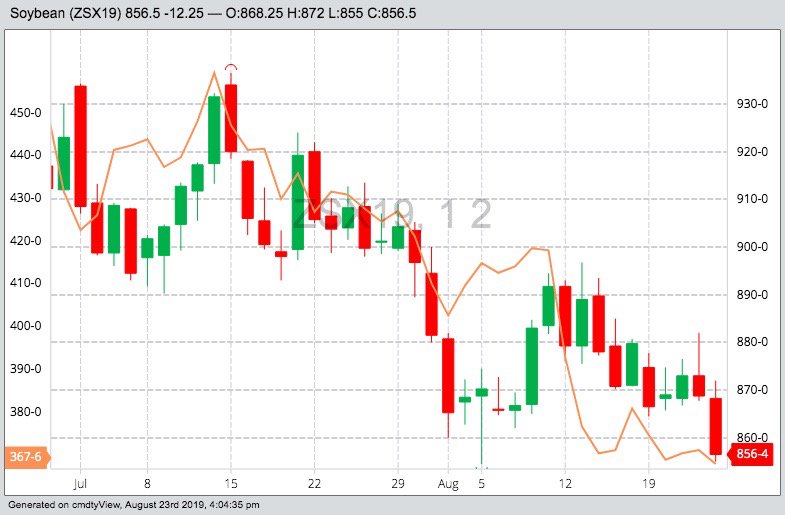Chicago | Reuters — U.S. corn futures hit a three-month low and soybeans neared a three-week bottom after China said it would impose additional tariffs on U.S. products including grains and soy, escalating the trade war between the world’s top two economies.
On the Chicago Board of Trade, soybean futures posted the biggest declines. China is the world’s top soybean buyer, and the trade row has hit the market hard. But corn pared losses and wheat futures turned higher.
CBOT November soybeans settled down 12-1/4 cents at $8.56-1/2 per bushel after hitting $8.55, the contract’s lowest since Aug. 5 (all figures US$).
Read Also

U.S. grains: Soy futures post biggest monthly gain in nearly five years on China trade optimism
U.S. soybean futures climbed to a 15-month high and posted their biggest monthly gain in nearly five years on Friday following a rally fueled by the prospect of revived exports to China.
December corn ended down 3-1/4 cents at $3.67-3/4 a bushel after dipping to $3.65-1/2, its lowest since May 13, while December wheat finished up 6 cents at $4.77-3/4 a bushel.
All three markets fell immediately after China announced retaliatory tariffs on about $75 billion worth of U.S. goods, including agricultural products.
But the impact on grains was seen as largely psychological, given that China already said this month it halted purchases of U.S. agricultural products.
“China is already buying zero (U.S.) soybeans; I don’t know if increasing the tariffs is going to change anything,” said Joe Vaclavik, president of Standard Grain, a brokerage and consulting firm.
“Today’s announcement was more about reinforcing negative market sentiment — which it did — and about communicating to traders that we are far from an agreement with China,” INTL FCStone chief commodities economist Arlan Suderman said in a client note.
Traders continued to monitor crop weather in the U.S. Midwest, where corn and soybean crops are behind in development following widespread spring planting delays.
Storms brought much-needed moisture to the Corn Belt this week, alleviating worries about emerging dryness. But forecasts called for cool temperatures over the next 10 days, at a time when crops could use a warm spell.
“I have questions about whether we are lacking the heat that we need to push these crops to maturity,” Vaclavik said.
After the CBOT close, the editors of the Pro Farmer newsletter projected the U.S. 2019 corn yield at 163.3 bushels per acre and the U.S. soybean yield at 46.1 bushels per acre, both below the U.S. Department of Agriculture’s most recent forecasts.
The estimates were released after an annual Pro Farmer crop tour this week of seven top producing states.
— Julie Ingwersen is a Reuters commodities correspondent in Chicago; additional reporting by Gus Trompiz in Paris and Naveen Thukral in Singapore.












